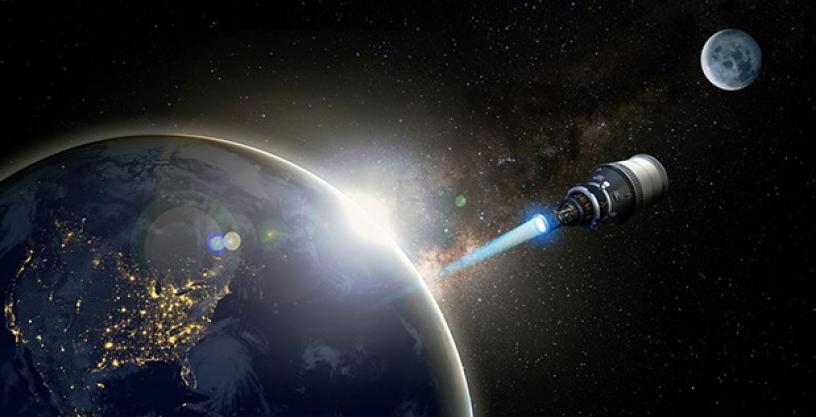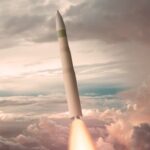The Defense Advanced Research Projects Agency has closed the books on its Demonstration Rocket for Agile Cislunar Operations program. Defense officials confirm the termination order went out late Monday. The move ends a five-year push to field a nuclear-thermal upper stage able to sprint between Earth and the Moon. According to industry sources, the agency pulled remaining funds into other space access lines once it judged the return on investment had vanished.
DARPA managers reached that conclusion after a short internal review. Our analysis shows two numbers drove the debate. First, launch prices keep falling. Second, expected performance gains from a nuclear engine looked steady rather than spectacular. When the gap narrowed, the cost advantage that once justified a reactor in orbit disappeared.
DARPA DRACO Origins and the Early Promise of Nuclear Thermal Propulsion
Program history goes back to 2020, when a handful of engineers pitched a small fission rocket under the nickname “Reactor On A Rocket,” or ROAR. The concept promised chemical-level thrust with much better specific impulse. Early tests on paper met every goal. Momentum grew, and Congress added seed money in the fiscal-year 2021 defense bill. No one predicted how quickly commercial launch economics would tilt the playing field.
Nuclear-thermal propulsion is simple in theory. Heat liquid hydrogen inside a reactor. Vent the gas through a nozzle. The exhaust velocity beats any chemical mix. The challenge sits in the core. It must survive thousands of hot starts without cracking. DRACO planned to solve that with High-Assay Low-Enriched Uranium fuel molded into ceramic-metal pebbles. Each pebble would carry fission heat out to the propellant stream while keeping fission products locked inside. Fabricating those fuel elements at scale proved harder than early trade studies suggested.
In 2023, NASA joined the project. The agency agreed to handle engine design while DARPA funded the spacecraft bus. Lockheed Martin and BWX Technologies won the Phase 2 and Phase 3 contracts. They proposed a reusable stage roughly the size of a standard Centaur. A Vulcan or Falcon 9 would have lifted it to a safe disposal orbit above 700 kilometers before reactor startup. Timelines pointed to an on-orbit hot-fire in 2027.
HALEU Fuel and Technical Hurdles in Thermal Propulsion
That plan never survived first contact with regulatory reality. Ground-test rules for space reactors changed in 2024 after public comment on new National Environmental Policy Act procedures. The Department of Energy added a full-up criticality demonstration requirement. Building the new test stand alone would add two years and close to $400 million.
Inside DARPA, cost modeling shifted in parallel. SpaceX flew more reuse missions. Standard orbital delivery dropped closer to $1,000 per kilogram, and Starship test flights hinted at even lower numbers once operational. Launch cost curves that underpinned the original DRACO business case now pointed a different direction. A chemical stack refueled in space could start to match the mass-fraction benefit of a nuclear stage without risking radioactive material.
Why DARPA Cancelled DRACO Despite Technical Achievements
The NASA budget proposal released on June 25 removed all nuclear thermal propulsion money for fiscal 2026. That sent the loudest signal yet. Defense officials confirm DARPA leadership met within hours of the rollout. They agreed to terminate the project and return unobligated funds to the Defense Department comptroller. Lockheed Martin received stop-work instructions the next day.
Technical progress to date was real. By early 2025, contractors had built full-diameter subscale cores, completed high-temperature flow tests with non-nuclear simulants, and produced a prototype liquid hydrogen pump set. A sixty-percent-scale nozzle survived 20 start cycles at 2,700 kelvin. Those hardware items will move into storage at NASA’s Glenn Research Center. The programmable hot-fire stand at Marshall Space Flight Center stays intact, ready for other propulsion work.
Why DRACO’s Nuclear Thermal Edge Lost Its Advantage
Why not pivot DRACO to a scaled-down demonstration? Agency planners weighed that option. They chose to walk away for four reasons:
- Launch economics – Heavy-lift cost reductions have outpaced nuclear-thermal performance gains.
- Schedule risk – Reactor safety reviews threatened to push launch past 2030.
- Cost growth – Test-stand upgrades and HALEU supply lines added roughly 50 percent to projected life-cycle cost.
- Strategic priorities – New Space Force maneuver requirements favor rapid, disposable stages over a single high-value nuclear bus.
NASA’s exploration directorate faces its own fallout. The agency wanted DRACO data to anchor human-Mars transit studies. With that path closed, engineers will fall back on solar-electric transport or staged chemical refueling. Mission planners concede those options add weeks to Mars transfer time but still fit within current life-support envelopes. A senior exploration official notes that “transit days are not free, yet neither are nuclear test ranges.”
What Comes After DARPA DRACO for Space Propulsion Missions
Lockheed Martin expressed disappointment in a brief statement but added that reactor technology matured under the effort and will feed future designs. BWX Technologies echoed that view and signaled interest in small-reactor power modules for lunar surface work.
Attention now shifts to nuclear-electric propulsion. The Air Force Research Laboratory runs the Joint Emergent Technology Supplying On-Orbit Nuclear Power program, known as JETSON. It funds studies for 10-kilowatt class fission power systems able to drive Hall-effect thrusters. A system in that range would favor long-duration maneuver rather than high-thrust burns, aligning well with geosynchronous satellite servicing. Recent advances in alternative propulsion, such as the scramjet engine technology demonstrator, also influence ongoing research priorities. DARPA insiders hint a follow-on proposal could appear by October.
The supply chain for High-Assay Low-Enriched Uranium remains a critical blocker. Only one domestic plant can make enough HALEU for even a small in-space reactor. The Department of Energy runs a limited centrifuge line in Ohio, but full production awaits additional appropriations. Defense officials say any future military reactor will require a stronger commercial base or international partners.
Safety oversight also shaped the decision. Current presidential guidance keeps Tier 2 reactor launches—below 20-percent enriched—inside agency authority, but White House review still applies if failure modes can spread debris. New analyses showed debris could cross populated land within days for a 500-kilometer insertion. That probability stayed low yet not negligible. Risk boards voted for chemical options unless the performance delta outweighed the public-perception cost. It did not.
Revised: DRACO’s Shutdown Sparks Global Rethink on Nuclear Spaceflight
Space Force operators care most about agile resupply and satellite displacement. A single nuclear stage looked attractive when plain hydrogen cost less than added launch mass. That equation flipped. Operational commanders now trust cheap throwaway stages more than a nuclear asset that requires weeks of coordination for each maneuver.
International interest in nuclear spaceflight continues. Chinese engineers presented a 2030 nuclear-electric tug concept at the Global Space Convention last month. Russian officials speak openly about reviving the old “Megawatt” nuclear-electric reactor plan. In parallel, U.S. research infrastructure, including the new hypersonics applied research facility, provides critical support for testing advanced space technologies. U.S. analysts expect both programs to face similar cost-benefit questions once commercial launch prices drop worldwide. For now, containment of radioactive material in orbit remains a universal challenge.
Congressional reaction was muted. The House Strategic Forces Subcommittee added report language asking for a joint NASA-DARPA study on nuclear-electric alternatives and a plan to dispose of any unused DRACO hardware. Hearings set for July 10 will examine the decision but early staff notes suggest limited opposition. One senior aide says lawmakers prefer to see real flight experiments, not extended ground tests that never reach space.
Academic researchers spent years modeling lunar transfer orbits tailored to a high-thrust nuclear stage. Those trajectories now shift into the reference category. Still, code written under DRACO grants will help chart future fast-cargo routes once higher power sources emerge. The University of Michigan team that ran the trajectory node already pivoted to megawatt solar-electric studies.
Funding that once flowed to DRACO will not vanish. DARPA redirected $150 million to rapid-responsive launch prototypes and another $60 million to on-orbit propellant depot trials. The agency wants data on how fast cryogenic propellant boils off in equatorial low-Earth orbit. That knowledge could support tanker concepts that fill a similar mission niche without nuclear systems.
SpaceX’s Starship program remains the wildcard. If the heavy booster achieves its promised mass fraction, a tanked-up Starship could position a payload in cislunar space with fewer maneuvers than any previous system. Defense analysts note, however, that Starship reliability still rests below operational thresholds. Four of nine integrated flights ended in explosions. Until that record improves, planners will hedge with mixed fleets.
Where U.S. Nuclear Space Propulsion Efforts Go Next
The federal technology road map for in-space reactors remains alive. National Security Presidential Memorandum-20 defines launch authorization tiers and leaves room for future spacecraft with enriched fuel under 20 percent. The memo encourages agencies to pursue advanced power systems but stresses life-cycle risk reduction. DRACO data on material performance and cryogenic management will feed that policy review in 2026.
Inside DARPA headquarters, staff are already drafting a lessons-learned package. Early notes list three themes: start small, align with commercial launch reality, and factor regulatory timelines into earned-value milestones. Future propulsion concepts may adopt a staged approach that demonstrates subsystems in isolation before committing to a full engine.
Why Investors and Agencies Are Hesitant
Commercial players keep watching. Blue Origin still runs an unfunded study of a hydrogen-oxygen upper stage fed by a 200-megawatt turbo-alternator reactor. Rocket Lab evaluates hybrid chemical-electric tugs that sip cryogenic methane. Investors remain cautious. As one venture partner put it, “Space reactors look sexy until you price the paperwork.”
Policy experts see opportunity in the pause. Nuclear-electric systems operate at lower temperatures and may avoid some of the materials stress that plagued thermal designs. They also produce continuous power for payloads, a feature attractive to surveillance and high-bandwidth relay. A senior AFRL scientist notes that kilowatt-scale reactors could power directed-energy payloads—a mission set rising on every future-threat chart.
Why Investors and Agencies Are Hesitant
Environmental groups reacted with guarded approval. They opposed DRACO over launch-failure risk but signaled willingness to discuss closed-cycle, fuel-pin reactors that never release hydrogen exhaust. The Union of Concerned Scientists plans a workshop later this year focused on containment standards for kilowatt-class space power plants.
Budget analysts stress that the Pentagon’s fiscal 2026 request still allocates $130 million for “advanced propulsion science and technology.” Line-item details point to both chemical and electric systems. The cancellation of a single marquee effort does not imply a retreat from deep-space maneuver goals. Instead, leadership appears to favor a diversified portfolio.
Looking forward, three scenarios top the list of nuclear-related space initiatives that could surface within the next 24 months:
- Kilowatt reactor for GEO servicing. Runs Hall-effect thrusters, extends satellite life.
- Surface fission power for Artemis base camp. Provides nighttime energy without oversized batteries.
- Hybrid chemical-nuclear demonstrator. Uses a small reactor to pre-heat methane and cut boil-off losses rather than deliver full thrust.
Each concept avoids the extreme thermal stress that doomed many earlier designs. They lean on modular construction and commercial partnerships rather than bespoke government hardware.
For now, DRACO hardware will rest under dust covers, and program managers will update their résumés. The moment signals a shift. Cheap launch changed the math. Nuclear power in space must now justify itself on endurance, autonomy, and mission flexibility, not on raw delta-V. Any new reactor will compete in a market that rewards fast iteration and low overhead.
Defense-Aerospace editorial staff will monitor the pivot from nuclear-thermal excitement to more modest, scalable power systems. Our coverage will follow up on proposals as they reach the budget books and the test stand.
REFERENCE SOURCES
- https://afresearchlab.com/
- https://arstechnica.com/space/2025/06/some-parts-of-trumps-proposed-budget-for-nasa-are-literally-draconian/
- https://en.wikipedia.org/wiki/Demonstration_Rocket_for_Agile_Cislunar_Operations
- https://keeptrack.space/space-brief/space-brief-2025-06-28/
- https://www.energy.gov/ne/articles/what-high-assay-low-enriched-uranium-haleu
- https://breakingdefense.com/2025/06/darpas-draco-nuclear-propulsion-project-roars-no-more/
- https://www.defense.gov/News/News-Stories/Article/Article/4227847/senior-officials-outline-presidents-proposed-fy26-defense-budget/



